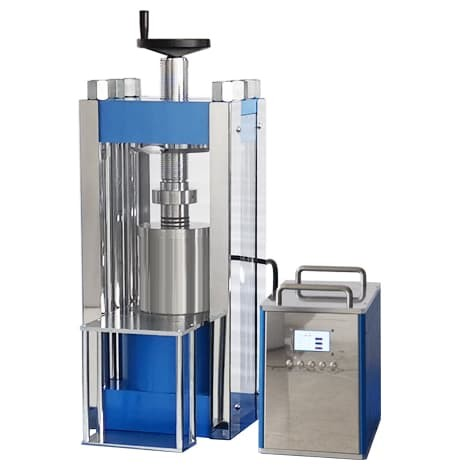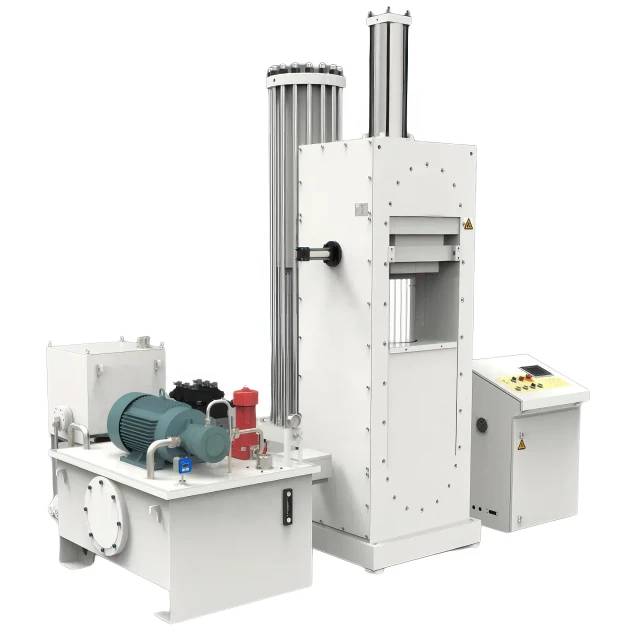Introduction
Cold Isostatic Pressing (CIP) is a powder compaction method that uses a fluid medium, such as water or oil, to apply uniform pressure to a powder sample. The process involves placing the powder into a sealed container and subjecting it to high pressure from all directions, resulting in a uniform and dense compact. CIP is a versatile process that can be used to produce a wide range of materials, including ceramics, metals, and composites. The process offers a number of advantages over traditional pressing methods, including high density, uniformity, and the ability to produce complex shapes. In this blog post, we will explore the benefits of CIP and its various applications in different industries.
Table of Contents
What is Cold Isostatic Pressing?
Cold Isostatic Pressing (CIP) is a process used to create materials with high density and uniform properties. It involves compacting powdered materials into a solid homogeneous mass before machining or sintering. CIP functions based on a principle proposed by Blaise Pascal, known as Pascal’s law, which states that pressure applied in an enclosed fluid is transmitted in all directions throughout the fluid without any change in the magnitude of the pressure.

Types of Cold Isostatic Pressing
There are two types of cold isostatic pressing: Wet Bag Technology and Dry Bag Technology. Wet Bag Technology involves filling a mold with powder outside the pressure vessel, then submerging the mold in the pressure fluid within the pressure vessel. Isostatic pressure is then applied to the external surface of the mold, compressing the powder into a solid mass. On the other hand, Dry Bag Technology involves filling the mold with powder while it's fixed in the pressure vessel. Then, isostatic pressure from the pressure liquid is applied to the external surface of the mold, compressing the powder into a solid mass with a compact microstructure. Dry Bag Technology is faster than Wet Bag Technology and is ideal for mass production of materials.
Advantages of Cold Isostatic Pressing
Green Strength is a term used to describe the ability of a molded material to withstand manipulation before it is completely hardened. Materials produced via cold isostatic pressing have high green strength. This means that such materials have a higher turnover as they can be sintered or machined faster than other materials.
Uniform Density is another advantage of cold isostatic pressing. This means that there will be uniform shrinkage when the material is going through other processes such as sintering. The uniform density can be attributed to the fact that the pressure used in CIP reaches every part of the material with equal magnitude.
Cold isostatic pressing is a simple process capable of producing high-integrity billets or preforms that exhibit little distortion or cracking when fired. Additionally, CIP is a cost-effective process that can reduce the number of manufacturing steps required, resulting in a more efficient production process.
Overall, Cold Isostatic Pressing is a valuable technique for creating high-performance materials with exceptional properties. It is widely used in the manufacturing of products such as ceramics, metal powders, and advanced composites. CIP can create materials with complex shapes and sizes, which makes it often used in the production of components for the aerospace, automotive, and healthcare industries.
Comparison with Other Pressing Methods
When it comes to pressing methods, there are a few options available, including hot isostatic pressing (HIP) and traditional die pressing. However, Cold Isostatic Pressing (CIP) has proven to be more efficient and versatile. Here's a comparison of CIP with other pressing methods:
Higher Density and Uniformity
CIP can achieve higher levels of density and uniformity in materials due to the use of isostatic pressure. This means that CIP materials have fewer defects and better mechanical properties than those produced by traditional die pressing.
Wider Range of Materials
CIP can process a wider range of materials, including ceramics, metals, and composites. On the other hand, HIP is limited to certain materials due to the high temperatures involved. This makes CIP a popular choice for various industrial applications.
Near-Net-Shape Parts
CIP has the ability to produce near-net-shape parts, which means less post-processing is required, saving time and money. Traditional die pressing requires extensive post-processing to achieve the desired shape and density.
Cost-Effective Solution
CIP is a cost-effective solution for producing high-quality materials, as it requires less energy and material waste compared to other methods. This makes it more economical and environmentally friendly.
Mechanical Properties
CIP materials have improved mechanical properties, including ductility and strength, making them more suitable for industrial applications.
Corrosion Resistance
CIP improves the corrosion resistance of a material, giving it a longer lifespan than most other materials.
Materials Produced
Cold isostatic pressing is used in powder metallurgy to produce complex shapes and dimensions. It is also used to produce refractory metals like tungsten, molybdenum, and tantalum. Additionally, CIP is used to manufacture automobile components such as bearings and oil pump gears. It can also be used in the production of sputtering targets, coatings, and thermal spray deposits.
In conclusion, Cold Isostatic Pressing (CIP) offers several benefits over other pressing methods, including higher density and uniformity, versatility, near-net-shape parts, cost-effectiveness, improved mechanical properties, and corrosion resistance. It is a popular choice for various industrial applications, including powder metallurgy, refractory metals, automobile components, and sputtering targets.

Advantages of Cold Isostatic Pressing
Cold Isostatic Pressing (CIP) is a versatile and efficient technique that offers significant advantages over other methods of material processing and shaping. This paragraph will detail some of the key advantages of CIP.
Improved Material Homogeneity
CIP subjects the material to high pressure from all directions while it is immersed in a pressurized liquid, usually water. This uniform pressure distribution helps to create a more homogeneous material, with fewer defects and inconsistencies.
Increased Density
CIP can increase the density of the material being processed. This increased density can lead to enhanced mechanical properties, such as improved strength and toughness.
Reduced Porosity
CIP can also help to reduce the porosity of the material being processed. This reduction in porosity can improve the material's resistance to corrosion and wear.
Shaping of Complex Geometries
CIP can be used for the shaping of complex geometries. This versatility makes it a valuable tool for researchers and manufacturers in many different industries.
Near-Net Shape Parts
CIP can produce near-net shape parts, which can reduce material waste and lower production costs. This is because the process can create parts that are very close to their final shape, reducing the need for additional machining or finishing.
Room Temperature Processing
CIP can be performed at room temperature, allowing for the processing of materials that are sensitive to high temperatures. This can be particularly useful in industries such as biomedical engineering, where temperature-sensitive materials are often used.
Elimination of Defects
CIP can help to eliminate defects in the material being processed. This can lead to an improvement in the quality of the final product, making it more reliable and durable.
In summary, CIP is a valuable tool for researchers and manufacturers in a wide range of industries. Its ability to improve material homogeneity, increase density, reduce porosity, shape complex geometries, produce near-net shape parts, perform processing at room temperature, and eliminate defects make it a versatile and efficient technique for material processing and shaping.

Applications of Cold Isostatic Pressing
The benefits of Cold Isostatic Pressing (CIP) are significant, and the technique is widely used in various industries for the manufacturing of high-quality components with excellent mechanical properties. CIP is a highly effective technique used in the manufacturing of a wide range of materials, including ceramics, metals, and polymers.
Aerospace
CIP is used in the aerospace industry to produce high-performance ceramic components for use in jet engines. The technique can produce complex shapes with high precision and improved density and strength, making it ideal for producing aerospace components.
Medical Device Manufacturing
CIP is used in the medical device manufacturing industry to produce orthopedic implants and dental prosthetics. The technique can produce components with low thermal expansion coefficients, making it ideal for use in high-temperature applications.
Automotive Industry
CIP is used in the automotive industry to produce components with improved mechanical properties. The technique can be used to consolidate powders, increase the density of materials, and enhance their mechanical properties.
Refractory Materials
CIP is used in the production of refractory materials. The technique can be used to produce components with uniform density and shape, making it ideal for producing refractory materials used in high-temperature applications.
Cemented Carbides
CIP is used in the production of cemented carbides. The technique can produce components with high precision and improved density, making it ideal for producing cemented carbides used in cutting tools and wear-resistant parts.
Composites
CIP is used in the production of composites. The technique can be used to produce components with improved mechanical properties and reduced porosity, making it ideal for producing composite materials used in various industries.
In conclusion, Cold Isostatic Pressing is a versatile technique that can be used in various industries for the manufacturing of high-quality components with excellent mechanical properties. The technique can produce complex shapes with high precision, improve density and strength, and reduce porosity. The applications of CIP are diverse, with the technique being used in industries such as aerospace, automotive, and medical device manufacturing.
Conclusion
In conclusion, Cold Isostatic Pressing (CIP) is a versatile and effective method for producing high-quality components with superior material properties. Compared to other pressing methods, CIP offers several advantages, including uniformity, high density, and improved strength. The applications of CIP are vast, from aerospace to medical devices. CIP is an essential technique for producing materials with high performance and reliability. With its many benefits, CIP is an excellent choice for anyone seeking to manufacture high-quality components for their industry.
Related Products
- Cold Isostatic Pressing Machine CIP for Small Workpiece Production 400Mpa
- Electric Lab Cold Isostatic Press CIP Machine for Cold Isostatic Pressing
- Automatic Lab Cold Isostatic Press CIP Machine Cold Isostatic Pressing
- Warm Isostatic Press WIP Workstation 300Mpa for High Pressure Applications
- Manual Cold Isostatic Pressing Machine CIP Pellet Press
Related Articles
- Understanding the Isostatic Pressing Process and its Types
- Isostatic Pressing Technology: Revolutionizing Ceramic Material Densification
- What is Isostatic Pressing Machine
- Selecting Isostatic Pressing Equipment for High-Density Molding
- Zirconia Ceramic Rod Production Processes: Isostatic Pressing vs. Dry Pressing












